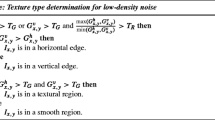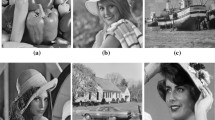Abstract
A PDE-based image inpainting method is proposed in this work for removing high-density impulse noise in images. In this model, the diffusion or inpainting process is driven by the difference curvature of the level curve. The proposed framework has two stages. In the first stage the noisy pixels are detected and they are piped to the second stage. In the second stage, these noisy pixels are inpainted using the information from their neighborhood. The connectivity principle is well realized and the edges and fine details are preserved well by the proposed model. The proposed method is compared (in terms of denoising capability) with the state-of-the-art impulse denoising models. The performance is quantified in terms of statistical quality measures. It is observed that the proposed method is capable of restoring images corrupted with high-density impulse noise (even up to 90 %). The experiments clearly demonstrate the effective restoration capacity of the proposed image inpainting model.

Similar content being viewed by others
References
Duan, F.; Zhang, Y.J.: A highly effective impulse noise detection algorithmfor switching median filters. IEEE Signal Process. Lett. 17(7), 647–651 (2010)
Pie-Eng, N.; Kai-Kuang, M.: A switching median filter with boundary discriminative noise detection for extremely corrupted images. IEEE Trans. Image Process. 15(6), 1506–1516 (2006)
Xuming, Z.; Youlun, X.: Impulse noise removal using directional difference based noise detector and adaptive weighted mean filter. IEEE Signal Process. Lett. 16(4), 295–299 (2009)
Hwang, H.; Haddad, R.A.: Adaptive median filters: new algorithms and results. IEEE Trans. Image Process. 4(4), 499–502 (1995)
Zhang, S.; Karim, M.A.: A new impulse detector for switching median filters. IEEE Signal Process. Lett. 9(11), 360–363 (2002)
Sochen, N.; Barm, L.; Kiryati, N.: Image deblurring in the presence of impulsive noise. Int. J. Comput. Vis. 37(1), 279–298 (2006)
Nikolova, M.: A variational approach to remove outliers and impulse noise. J. Math. Imaging Vis. 20(1), 99–120 (2004)
Wang, Z.; Zhang, D.: Progressive switching median filter for the removal of impulse noise from highly corrupted images. IEEE Trans. Circuits Syst. II. 46(1), 78–80 (1999)
Eng, H.L.; Ma, K.K.: Noise adaptive soft-switching median filter. IEEE Trans. Image Process. 10(2), 242–251 (2001)
Ko, S.J.; Lee, Y.H.: Center weighted median filters and their applications to image enhancement. IEEE Trans. Circuits Syst. 38(1), 341–347 (1991)
Sun, T.; Neuvo, Y.: Detail-preserving median based filters in image processing. Pattern Recognit. Lett. 15(4), 341–347 (1994)
Florencio, D.A.; Schafer R.W.: Decision-based median filter using local signal statistics. In: Proceeding of the SPIE Visual Communications and Image Processing, pp. 268–275 (1994)
Lee, SH.; Seo, JK.: Noise removal with gauss curvature-driven diffusion. IEEE Trans. Image Process. 14(7), 904–909 (2005)
Jidesh, P.; George, S.: Curvature driven diffusion coupled with shock for image enhancement/reconstruction. Int. J. Signal Imaging Syst. Eng. 4(4), 238–247 (2011)
Jidesh, P.; George, S.: Gauss curvature-driven image inpainting for image reconstruction. J. Chin. Inst. Eng. 37(1), 122–133. doi:10.1080/02533839.2012.751332 (2012)
Gonzalez, R.C.; Woods, R.E.: Digital Image Processing. Prentice Hall, Upper Saddle River (2001)
Zhou, W.; Bovik, A.C.: Image quality assessment: from error visibility to structural similarity. IEEE Trans. Image Process. 13(4), 1–14 (2004)
Yang, G.J.; Huang, T.S.; Tang, G.Y.: Fast two-dimensional median filtering algorithm. IEEE Trans. Acoust. Speech Signal Process. 1(1), 13–18 (1979)
Montesinos, P.; Sun, Q.S.; Heng, P.A.; Chen, Q.; De Xia, S.: Adaptive total variation denoising based on difference curvature. Image Vis. Comput. 28(7), 298–306 (2010)
Chan, T.F.; Shen, J.: Non-texture inpainting by curvature driven diffusions (CDD). J. Vis. Commun. Image Represent. 12(4), 436–449 (2001)
Kang, S.; Chan, T.F.; Shen, J.: Euler’s elastica and curvature-based image inpainting. SIAM J. Appl. Math. 63(7), 564–592 (2002)
David, G.; Chi-Wang, S.: On the Gibbs phenomenon and its resolution. SIAM Rev. 39(4), 644–668 (1997)
Canny, J.: A computational approach to edge detection. IEEE Trans. Pattern Anal. Mach. Intell. 8(6), 679–698 (1986)
Jidesh, P.; George, S.: A time-dependent switching anisotropic diffusion model for denoising and deblurring images. J. Mod. Opt. 59(2), 140–156 (2012)
Author information
Authors and Affiliations
Corresponding author
Rights and permissions
About this article
Cite this article
Jidesh, P., Bini, A.A. A Curvature-Driven Image Inpainting Approach for High-Density Impulse Noise Removal. Arab J Sci Eng 39, 3691–3713 (2014). https://doi.org/10.1007/s13369-014-0983-0
Received:
Accepted:
Published:
Issue Date:
DOI: https://doi.org/10.1007/s13369-014-0983-0




